This post is based off of our second annual cheff’s table - a home cooked dining experience that educates through food. If you live in or pass through the Bay Area and would like to attend a future one, let me know.
Greetings guest! Your table is ready, if you would kindly follow me please.
This seating, we’ll be embarking on a culinary journey exploring climate change.
Take a look at the candle in front of you. It offers a few hints about what we need to transition our planet to a stable climate.

This candle is a source of warmth. We’ve transitioned from open fire to coal and now to natural gas for warmth in our homes. Doing so has reduced our emissions, but we need to get off burning fossil fuels altogether. As we look to the future, technology holds the promise of fossil-free warmth. Heat pumps are one example of a superior, all-electric product that can be powered by renewable energy. Now, we just need to increase the rate of adoption.
This candle is a source of light. As we’ve moved from candles to incandescent light and now to LED bulbs, the way we light our homes has become ever more efficient. As developing countries mature, we expect their energy usage to increase. So with the pie growing, not only do we need our energy to go green, we also need to dramatically increase our efficiency everywhere else we use it.
More surprising perhaps, this candle is a source of sustenance. You see, this candle is made from rosemary and garlic infused browned butter. To reach a stable climate, we need to transform our entire system of food. For now, start by transforming this candle into a dip for your bread.

Over the course of this meal, we hope to give you gastronomic symbols to remember two key facets of the transformation we need – decreasing the footprint of what we eat, and decreasing the footprint of what we don’t eat.
As it happens, these two are amongst our most effective tools to counteract climate change. Project Drawdown, a non-profit that ranks climate solutions, has “reduced food waste” and “plant-rich diets” at the top of _all_ known climate solutions. Granted, this doesn’t mean we can just do these and call it a day. We need to do everything on their list. But these are some of the highest leverage.

It can often feel like there’s not much that we can do as individuals to combat climate change. Well, shifting the way we eat is one massive way to do so. It might not seem like much from an individual perspective, but collectively our efforts add up. And hopefully this meal will show you how to make the shift easier.
What We Eat
How do we decrease the footprint of what we eat? The spoiler from Project Drawdown is that we eat plant-rich diets. But what does that mean and how do we go about doing it without it feeling like a sacrifice?
Let’s see. Starting with…
ton for ton
Our next course, the salad course. For the table, we have a large bowl of pomegranate and padron pepper salad with a mushroom garum dressing, avocados, and sliced almonds. Beside it we have a medium bowl of pan seared chicken and a tiny bowl of dry brined steak.

The kicker? These three dishes all have the same carbon footprint. The salad is only that “small” because of the avocados, which have larger footprints due to the deforestation and water consumption involved in their cultivation. Without them, the salad’s portion would be much too big for the meal.
Adopting a plant-rich diet isn’t synonymous with a strictly vegetarian or vegan lifestyle. It doesn’t need to be an ‘all-or-nothing’ approach. In fact, even Project Drawdown’s definition of “plant-rich” includes an average of 57g of red meat a day. Visually, we can see that just reducing our red meat intake would already make a meaningful difference.
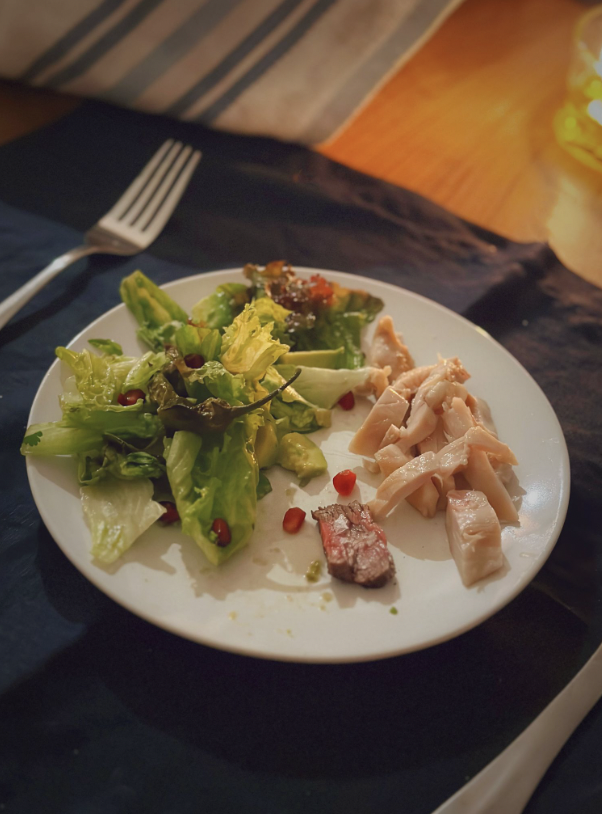
To put some numbers to it, 14% of global emissions come from our livestock, with beef causing 10x the emissions of chicken pound for pound, and chicken 10x some plants! A couple factors go into it – at a high level, just think about all the land we had to convert from carbon-sinking forests to grazing land to raise animals, and all the carbon-intensive fertilizers and energy needed to make feed just for animals.
Beef’s outsized impact is not merely due to the size of cows necessitating more feed and land, but also because they burp and fart methane, a potent greenhouse gas that has 80x the warming power of carbon dioxide (in the short term).
If eating entirely plant-based would be hard for you, perhaps if you’re at a restaurant torn between the chicken and beef options, choose the chicken. Alternatively, opt to eat plant-based just once or twice a week, or try to fill more of your plate with veggies. The fiber in veggies is healthy in other ways, but that’s a separate story.
seitanic saucery
A common concern with eating more plant-rich is that it’d be hard to get sufficient protein, or that you’d just be eating all tofu all the time. But tofu isn’t the only meat-alternative protein option. Wheat gluten, also known as seitan, can be upwards of 80% protein by calories.
Depending on how you cook them, their texture can be remarkably similar to meat. As a matter of fact, there’s a longstanding tradition of using seitan to make mock meats in Chinese cuisine rooted in Buddhism.
Here we have shallow fried gluten puffs with a kung pao inspired glaze, served with roasted peanuts, bell peppers, and mangos, garnished with sesame and nutritional yeast. Accompanying it is a house recipe mala chili crisp for an optional kick.
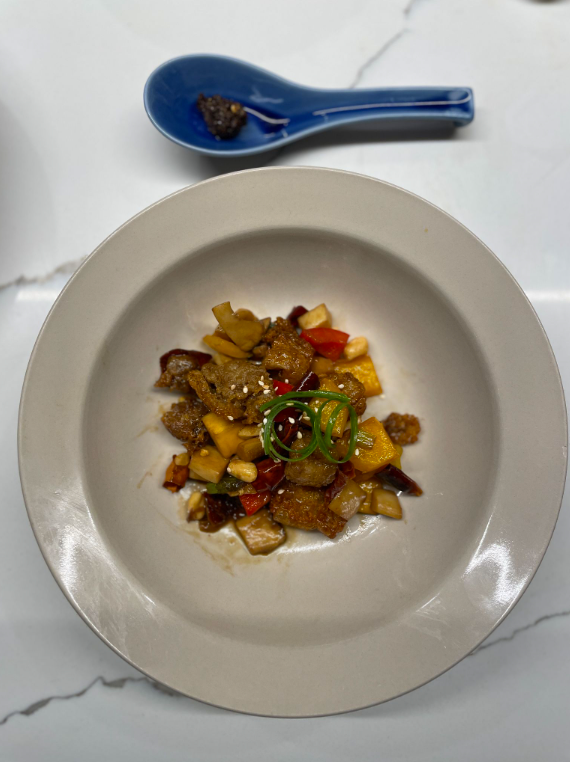
Although you’re unlikely to eat your weight in nutritional yeast, it can serve as an additional source of protein, while also being a tasty topping. Nutritional yeast is 70% protein by calories and can intensely boost the deliciousness of your food. Other quality protein sources are lupini beans (55%), tempeh (45%), and certain seaweeds (up to 45%).
If these options still leave you skeptical about building muscle mass, we can look to world class vegan powerlifters for what’s possible. For those that use supplements but don’t like the taste of pea protein powder, there’s now animal-free whey protein.
but where are you REALLY from?
This next course is shakshuka baked in a puff pastry tart. Each guest gets two tarts – one uses San Marzano tomatoes from Italy and the other tomatoes from nearby Los Gatos in Northern California.
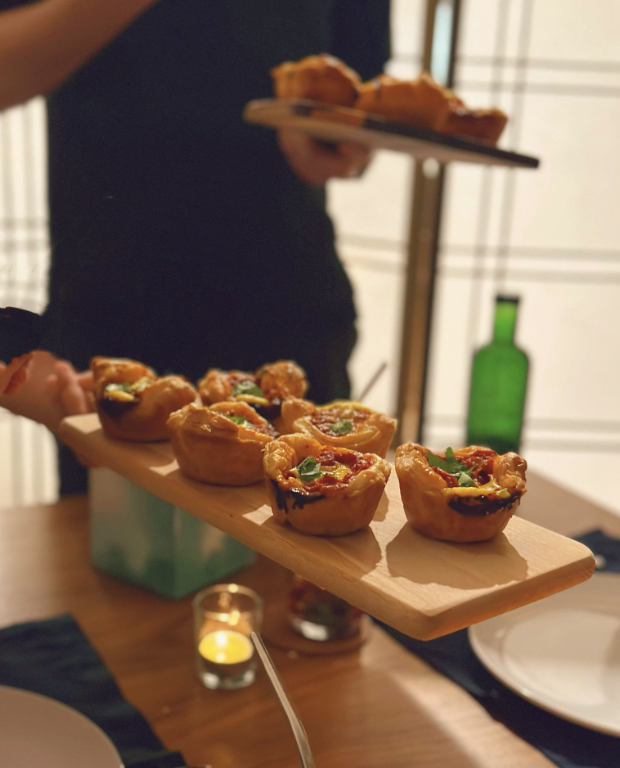
Without knowing which is which, try both and decide which you like best.
Eating local gets a lot of attention, and while it’s true that the farther that a food goes, the more emissions are involved, the climate impact from transportation is generally a tiny fraction of the bigger picture. And most of that impact is from last mile delivery.

Building off of what we learned from the previous courses, what you eat matters more than where it came from. So don’t feel guilty if you liked the San Marzano shakshuka better. But if you couldn’t taste the difference between the two, might as well go for the local one next time!
One nuance in this topic is that emissions calculations are very complicated and we do not yet have good tools in place to do them systemically. Most of the data we have are averages across a handful of farms’ lifecycles. The carbon footprint of one farm could be drastically different from that of another, even in the same region. For example, a tomato grown in a greenhouse can be 9x worse than one grown in an open field. For now, all we can do is be handwavy and generalize about categories of food. It doesn’t diminish the fact that eating more plant-rich is the highest leverage change we can make in our diet.
What We Don’t Eat
So far everything we’ve been focused on is the footprint of what we eat. Now it’s time to consider the footprint of what we don’t eat. How much of America’s food do you think gets tossed in the trash?
…
…
The answer is almost 40%! And of that amount, over 40% of it is wasted in our own homes. Another 40% is wasted in grocery stores and restaurants. The earlier parts of the supply chain contribute to the smaller remainder.
Why does this matter? Because when food is thrown out, it sits in landfills and releases methane as it rots, which you’ll remember is extra bad. On top of that, when you account for all the energy, agricultural inputs, and more involved in growing all that food that went to waste, food waste is about 6% of global emissions.
Armed with a few techniques, you can find ways to use ingredients when they’re past their prime and avoid the dump.
grateful dead
Have you had a bag of spinach sitting in your fridge looking too wilted and unappetizing to eat? Or herbs that you bought for one dish that now you don’t know what to do with? One use is to puree them into a salad dressing.
A dressing can wonderfully incorporate large quantities and varieties of different greens, no matter their age, turning them into something fresh and vibrant. The end result can be used not only on salads, but also on rice bowls, stir fries, sandwiches, and more. Plus, if you make a big batch, you can freeze the dressing in an ice cube tray to make it last even longer and be perfectly portioned for individual meals!
Here we have roasted vegetables with a greek goddess dressing made with spinach, cilantro, mint, and dill, garnished with grated lemon zest.
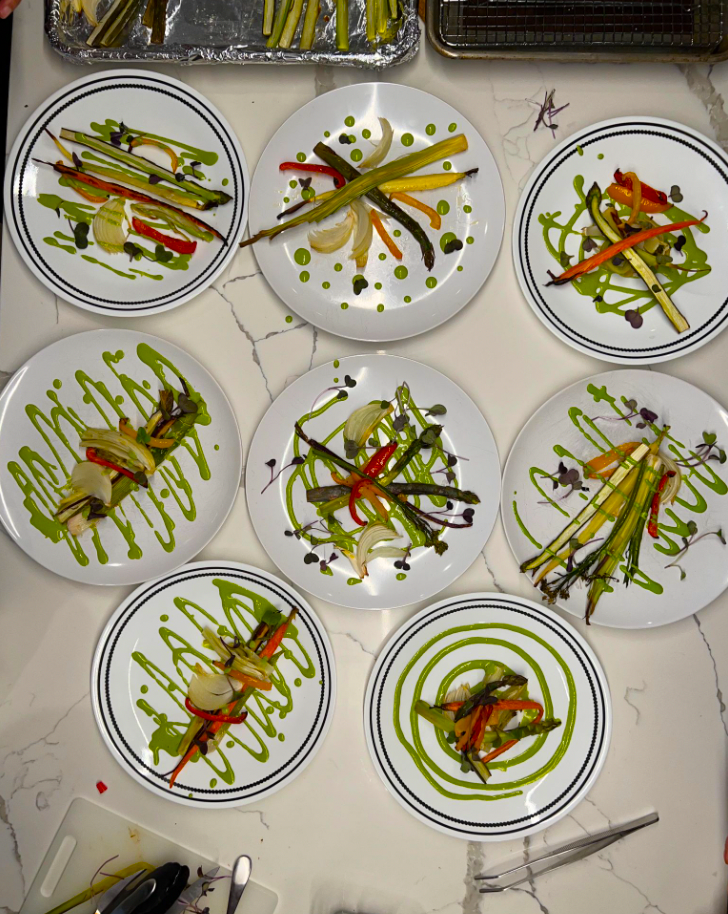
Zesting is a great way to make use of the citrus peels you’d normally just throw out. They can add contrast and brightness to a dish.
Some other ideas to find new life for ingredients are:
- Turning leftover rice into fried rice. Actually, that’s encouraged as the kind of rice to use since the moisture content is lower
- Blanching or pickling veggies. Along with pureeing, those are other techniques you can add to your repertoire
- Baking stale bread into croutons. They add a crunchy texture to your plant-rich salads
- Baking overripe bananas into banana bread
- Putting veggie and meat scraps into a stock. Just add water! Stock can store in your fridge for a long time and serve as the basis for many sauces, braises, and stews
For more advanced cooks, we can look to Noma for inspiration. They’re always pushing the boundaries with new ways to love unloved foods and they wrote a comprehensive book on fermentation, which not only extends ingredients’ lifetimes, but brings complexity to previously simple flavors.
As for the food waste that you really have no way to deal with, there’s a startup making a new kitchen bin for it. Instead of smelly and liquidy compost that you have to throw out often, Mill’s bin dehydrates what you put into it, shrinking it down and removing the stink. The end result can then be used as animal feed.
lost: bread
And for our final course, we’ve got… milk?
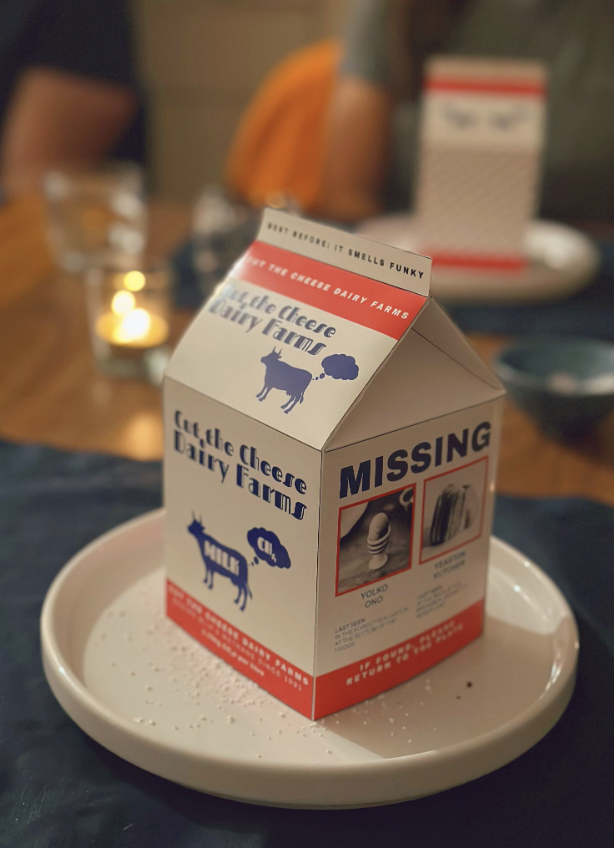
Do you throw out your milk as soon as it’s past the expiration date? It turns out, food doesn’t go bad the day it crosses the “best before”. Those dates are usually set by manufacturers based on “optimal” taste, not food safety. Eggs, for example, are usually still edible 3-5 weeks after the date on the carton.
When you want to evaluate safety, use your senses, not the label. If it doesn’t smell funky, you don’t see mold, and you’ve cooked it to a proper temperature, your food should generally be safe. This is yet another reason to eat more plant-rich – it’s much harder to mess up food safety when it comes to plants.
The question remains though: what do you do with milk and eggs past their prime? In French, the name for French toast is “pain perdu”, or literally “lost bread”. It’s a decadent way to combine the bread forgotten at the bottom of the drawer, the milk you’re worried about drinking cold, and eggs you don’t want to eat raw anymore (if you ever did that to begin with).
So for our real final course, we have a croissant French toast with crème fraiche, fresh berries, and powdered sugar.
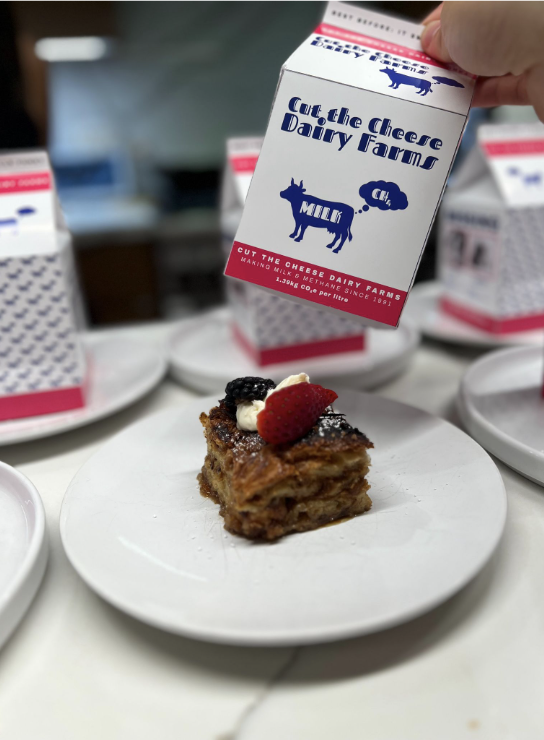
And if you want another helping of knowledge with your dessert…
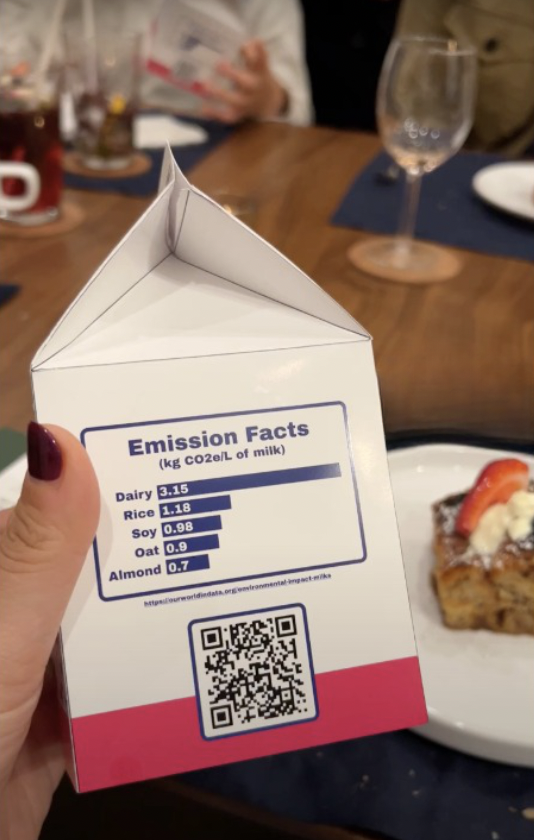
And with that, we thank you for dining with us. Your meal comes out to ~3 kg carbon dioxide equivalent of emissions. If you would like to pay online, Wren offers a way to offset your carbon footprint.
As a parting gift, we’d like to present you with a copy of our menu from this meal. We’ve included a takeaway from each dish to look back on.

We hope you’ve had a wonderful time with us and hope to see you again!
Afterword
If this inspired you to think about how we need to remodel our food infrastructure, let’s connect. I’m currently investigating where software can be levered to effect change in the system.
I’m still early in my journey, but as a starting point, the following are some of the biggest areas beyond our own diets that I’m seeing, and the companies already doing something about it. Let me know if there’s a company I should know about, or an area I’m missing or am misinformed about!
Carbon Accounting: Earlier I mentioned that knowing the exact emissions from a specific food product is still hard. Clearer data would illuminate the areas most in need of improvement.
- Watershed has a product for supply chain accounting
- Mammoth is specifically tackling consumer packaged goods
- Hectare is targeting agriculture
As a caveat to the rest of the sections below, because we aren’t accounting well yet, all numbers are estimates. For some I found conflicting sources and I’ve taken my best guess at which to use.
Cow Burps: Of the 14% of global emissions from livestock, 6% of it comes the methane of cow farts and burps.
- Windfall Bio is converting the methane into soil nutrients
- Alga is supplementing cow feed with algae to reduce the methane
- Lasso helps cattle farmers change practices to decrease emissions
Alternative Proteins: For some, the taste of meat is hard to do without. One hypothesis for reducing livestock emissions is to produce better alternatives, whether it’s cultivating meat in labs with less emissions, or creating substitutes that taste meat-like from plant-based ingredients.
- Umaro is making bacon substitutes with seaweed proteins
- Prime Roots is making deli meat substitutes with koji
- Upside Foods is growing meat directly from animal cells
- Formo is producing animal-free dairy
- Wildtype is creating cultivated seafood
This space seems to have the most competition, with over 200 companies working in it.
Soil Health: Soil is a major sink for the carbon we put into the atmosphere. And yet we’ve severely degraded our soils from farming practices that prioritize short term gains. If we improve soil content by 3%, we could reduce global emissions by 5%.
- Yardstick is enabling better soil carbon measurements
- Agros is helping farmers switch practices to restore their soils
Food Waste: We talked about the residential changes we can make, but we also need change in grocery stores and restaurants to help reduce the other 40% of the 6% of emissions from food waste.
- Afresh helps reduce waste in grocery through better inventory management
- Apeel is making produce last longer
- Too Good To Go helps restaurants sell their surplus at the end of the day
Cold Chain: Cooling makes up 10% of global emissions. The refrigeration in the supply chain needed to preserve foods during transportation and storage is estimated at 10-20% of that.
- Artyc is making refrigerant-free cooling containers
- Snofox helps with monitoring and increasing efficiency
Ocean Shipping: Though what we eat matters more than where it came from, traveling further does still mean more emissions. Food shipped across continents often happens by ocean freight, which accounts for 2% of global emissions.
- Nautilus is improving the efficiency of ships with predictive navigation
- Amogy is creating an alternative fuel from ammonia for boats
- Seabound is working to directly capture CO2 from ships
Rice Farming: Flooding rice paddies breeds methane-producing microbes, which accounts for 1% of global emissions.
- Green and Seed is developing a system that increases the sustainability of rice farming
Fertilizers: 1% of global emissions come from the carbon-intensive process of making fertilizers.
- Nitricity is building better reactors to produce fertilizers with lower emissions
- Chapul Farms farms insects and one of their byproducts is a fertilizer replacement
Acknowledgements
For this post, thank you to Jamie Wong, Lyn Stoler, Ivy Xu, Doug Qian, Amer Ameen, Jessie Duan, Joanna Chen, and Rox Guo for all your edits!
For the tasting menu, thanks to Doug, who helped conceive the concepts in a talk we gave at a climate conference and crushed it as back of house with impromptu improvements. To Jamie for your compelling storytelling that shaped the narrative of this, your imaginative carton design, and deep climate knowledge. To Janice for your vibrant front of house energy. To Connie, our thoughtful back of house’s back of house. To our taste testers Wes, Alice, Jessie, Dean, Joanna, and Brian, whose feedback helped shape the final menu into what it was. And our guests Ivy, Romain, Lyn, Chris, Eric, Soraya, Alina, and Helena for an unforgettable evening.
And finally, thanks to Jon Ng, my co-conspirator in this and many other cooking adventures. Couldn’t have done it without your impressive spreadsheets, sick dining space, and general partnership.